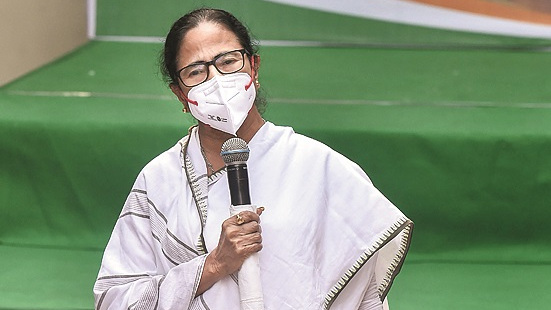The outcome of the West Bengal assembly election led to Chief Minister Mamata Banerjee beating off a sustained challenge from the Bharatiya Janata Party and securing a third term. The verdict in favour of the All India Trinamul Congress was conclusive, both in terms of seats and popular votes. At the same time, the scale of Mamata Banerjee’s victory took many by surprise. Although the dip in the turnout in the final three phases of the polls was widely expected to benefit the AITC, anecdotal wisdom believed the contest would be extremely close, with the winner securing between 150 and 160 seats in the 294-member assembly.
Predictably, Mamata Banerjee’s emphatic victory came as either a pleasant or a rude surprise to the supporters of the two sides. Those elated by the scale of the victory promptly anointed her as the prime minister-in-waiting and simultaneously asserted that the BJP was completely out of sync with the political and cultural traditions of West Bengal. On their part, dispirited BJP supporters came to two broad conclusions. First, a section of them believed that the counting process on May 2 was marred by cheating. Second, the ire of supporters who believed that the state would witness its first BJP government was directed at those who were responsible for the selection of candidates. It was felt that the nomination of a disproportionate number of defectors from the AITC had diluted the appeal of the Sonar Bangla promise and blunted the anti-incumbency against the regime.
In the normal course, any emphatic verdict would have led to hair-splitting analysis in all camps. However, the grim reality of the Covid-19 pandemic and the suspension of normal life has meant that public discourse has steered away from the election outcome. Additionally, the wave of violence against BJP activists that followed the counting of votes has meant that the leadership of the principal Opposition party is too preoccupied with trying to salvage its organization and protecting its people to devote attention to dissecting an election that ended up in disappointment.
Yet, a clinical analysis of the 2021 outcome is crucial, not least because it provides a corrective to sweeping generalizations and self-serving conclusions. The analysis that follows is substantially based on the post-poll surveys by the Centre for the Study of Developing Societies-Lokniti, a reputed academic body that has tracked polls over time and whose findings consequently allow comparisons with past elections. While these data aren’t terribly relevant as a tool of prediction, they are invaluable in understanding the social matrix of politics and gauging voting behaviour.
At a macro level, the support base of the two parties gives a clear indication as to why one side prevailed and the other failed to make the grade. If the population of Bengal is divided in terms of religious communities, the AITC has support among both the majority Hindus who account for roughly 70 per cent of the population and the Muslim minority that accounts for around 27 per cent. The BJP, on the other hand, has negligible Muslim support and its identity is that of a Hindu party. In other words, the ability of the BJP to make political headway is solely dependent on its ability to secure maximum Hindu support. In a first-past-the-post system, the BJP also hoped that the consolidation of Hindu votes would be complemented by a significant number of Muslims choosing between the AITC and the Third Front comprising the Left Front, the Congress and the Indian Secular Front of Pirzada Abbas Siddiqui.
According to the Election Commission data, Bengal witnessed a spectacular two-party contest, with the AITC bagging 47.9 per cent and the BJP 38.1 per cent of the popular vote. The Left Front secured 5.67 per cent and the Congress 2.93. If the ISF votes are added to the kitty, the Mahajot polled less than 10 per cent and secured just one seat.
The disaggregated results, as gleaned from the CSDS-Lokniti findings, suggest that the 9.8 per cent gap in votes between the AITC and the BJP was exclusively a function of the Muslim support for Mamata Banerjee. The AITC had secured 51 per cent Muslim support in 2016. This rose to 70 per cent in the 2019 Lok Sabha polls and climbed to a dizzying 75 per cent in 2021. Add to this the suggestion (still not fully corroborated) that the turnout of Muslim voters exceeded that of the Hindus by at least three per cent. By contrast, the AITC support among Hindu voters was 43 per cent in 2016, 32 per cent in 2019 and 39 per cent in 2021.
Mamata Banerjee has demonstrated that it is possible to win a resounding majority without the emphatic support of a state’s majority community.
In 2019, the BJP had won 18 of the 42 Lok Sabha seats from the state by securing 57 per cent of the votes of Hindus. In 2021, it secured 50 per cent, which was a small decline from 2019. To win a majority, the BJP needed at least 60 per cent of all Hindu votes in the state. Although it won the support of a majority of Hindu voters, the religious demography of the state meant that it needed a Hindu consolidation that was almost equal in scale to the Muslim support for the AITC.
A further disaggregation of the Hindu votes along caste lines indicates that, as in 2019, the strongest support for the BJP came from the other backward classes and Dalit communities. According to the CSDS-Lokniti findings, it secured 49 per cent support from OBCs, 59 per cent from Rajbanshis, 58 per cent from Namashudras (including Matuas), 52 per cent from other Dalit communities and 46 per cent from adivasis. The AITC trailed the BJP in support from all sections. However, Mamata Banerjee was successful in narrowing the gap among nearly all these subaltern Hindu communities, and particularly the adivasis. Even among upper castes, otherwise a source of BJP strength in other states, the BJP led the AITC by merely 46 per cent to 42 per cent.
Mamata Banerjee’s ability to narrow the BJP lead among Hindu voters was particularly marked among the poorer sections. In 2019, the BJP led the AITC by a whopping 34 points, a gap that was reduced to just three per cent in 2021. Yet, it is important to note that the BJP had a lead among all the economic classes of Hindus.
The CSDS-Lokniti findings are significant. They suggest that Mamata Banerjee was able to overcome the BJP challenge with a last-minute improvement in government services to the poor. This secured her enough incremental votes — particularly in areas where the Muslim population is relatively low — to edge past the BJP. She also took advantage of the BJP’s patchy organizational and social penetration by targeting the weakest links in its support base. However, it is ominous that increased support for the BJP is directly correlated to the numerical strength of the Muslim community in constituencies: the more the concentration of Muslims, the greater was the Hindu vote for the BJP. This prompts the unfortunate conclusion that the sectarian polarization in West Bengal is far more intense than appears on the surface. The post-poll violence is likely to embitter the mood further, not least because the underlying narrative centres on communal attacks.
A dissection of the poll results doesn’t support the argument that the BJP’s fundamental political approach is flawed. It indicates that the party needs to deepen its local roots and focus on internalizing a narrative that incorporates regional particularities. For all the energy it demonstrated in the campaign, the BJP needs to acquire additional social depth in a state where political assumptions are being turned upside down.











